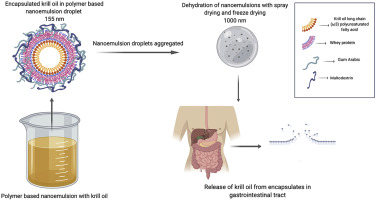当前位置:
X-MOL 学术
›
Food Hydrocoll.
›
论文详情
Our official English website, www.x-mol.net, welcomes your
feedback! (Note: you will need to create a separate account there.)
The effect of spray-drying and freeze-drying on encapsulation efficiency, in vitro bioaccessibility and oxidative stability of krill oil nanoemulsion system
Food Hydrocolloids ( IF 11.0 ) Pub Date : 2020-09-01 , DOI: 10.1016/j.foodhyd.2020.105890 Tamer Mohammed El-Messery , Umit Altuntas , Gokce Altin , Beraat Özçelik
Food Hydrocolloids ( IF 11.0 ) Pub Date : 2020-09-01 , DOI: 10.1016/j.foodhyd.2020.105890 Tamer Mohammed El-Messery , Umit Altuntas , Gokce Altin , Beraat Özçelik

|
Abstract A nanoemulsion system was employed to encapsulate the krill oil with different concentration. The combination of whey protein concentrate, maltodextrin and gum arabic with the ratio of 8:2:0.5 was used in nanoemulsion formulation to enhance nanoemulsion stability, as well as to construct the wall part of the encapsulates. Two different drying methods; freeze-drying and spray-drying were applied on krill oil nanoemulsion systems to obtained powder encapsulates. The physical characterization of nanoemulsions and chemical stability of krill oil in terms of oxidative stability and in vitro bioaccessibility (%) were evaluated before and after drying processes to understand the effect of different drying techniques on encapsulation ability of nanoemulsion systems. Dehydration of nanoemulsions with spray-drying caused approximately 7 folds increments on particle size. The sample with 8% (w/v) of krill oil concentration had an optimum encapsulation efficiency that was calculated 72% in spray-dried nanoemulsion and 67% in freeze-dried nanoemulsion. Both spray-dried and freeze-dried krill oil nanoemulsions showed similar oxidative stability in 8% (w/v) concentration during the 15 days storage period. In vitro bioaccessibility of encapsulated krill oil was changed between 32.7 to 72.4% and 20.0–83.0% in freeze-dried and spray-dried nanoemulsions, respectively. Still, the spray-drying process is recommended for the dehydration of krill oil nanoemulsion with 8% (w/v) concentration because a better encapsulation efficiency and the higher in vitro bioaccessibility was obtained compared to freeze-dried nanoemulsion systems at the same concentration of krill oil.
中文翻译:

喷雾干燥和冷冻干燥对磷虾油纳米乳体系包封率、体外生物可及性和氧化稳定性的影响
摘要 采用纳米乳体系对不同浓度的磷虾油进行包封。将浓缩乳清蛋白、麦芽糊精和阿拉伯树胶以8:2:0.5的比例组合用于纳米乳液配方中,以增强纳米乳液的稳定性,并构建胶囊的壁部分。两种不同的干燥方式;将冷冻干燥和喷雾干燥应用于磷虾油纳米乳液体系,以获得粉末胶囊。在干燥过程之前和之后评估了纳米乳剂的物理特性和磷虾油的化学稳定性(氧化稳定性和体外生物可及性 (%)),以了解不同干燥技术对纳米乳剂系统包封能力的影响。喷雾干燥纳米乳液的脱水导致粒径增加约 7 倍。磷虾油浓度为 8% (w/v) 的样品具有最佳包封效率,经计算,喷雾干燥纳米乳液为 72%,冷冻干燥纳米乳液为 67%。在 15 天的储存期内,喷雾干燥和冻干磷虾油纳米乳剂在 8% (w/v) 浓度下显示出相似的氧化稳定性。在冷冻干燥和喷雾干燥的纳米乳液中,包封磷虾油的体外生物可及性分别在 32.7% 至 72.4% 和 20.0% 至 83.0% 之间变化。仍然,
更新日期:2020-09-01
中文翻译:

喷雾干燥和冷冻干燥对磷虾油纳米乳体系包封率、体外生物可及性和氧化稳定性的影响
摘要 采用纳米乳体系对不同浓度的磷虾油进行包封。将浓缩乳清蛋白、麦芽糊精和阿拉伯树胶以8:2:0.5的比例组合用于纳米乳液配方中,以增强纳米乳液的稳定性,并构建胶囊的壁部分。两种不同的干燥方式;将冷冻干燥和喷雾干燥应用于磷虾油纳米乳液体系,以获得粉末胶囊。在干燥过程之前和之后评估了纳米乳剂的物理特性和磷虾油的化学稳定性(氧化稳定性和体外生物可及性 (%)),以了解不同干燥技术对纳米乳剂系统包封能力的影响。喷雾干燥纳米乳液的脱水导致粒径增加约 7 倍。磷虾油浓度为 8% (w/v) 的样品具有最佳包封效率,经计算,喷雾干燥纳米乳液为 72%,冷冻干燥纳米乳液为 67%。在 15 天的储存期内,喷雾干燥和冻干磷虾油纳米乳剂在 8% (w/v) 浓度下显示出相似的氧化稳定性。在冷冻干燥和喷雾干燥的纳米乳液中,包封磷虾油的体外生物可及性分别在 32.7% 至 72.4% 和 20.0% 至 83.0% 之间变化。仍然,











































 京公网安备 11010802027423号
京公网安备 11010802027423号